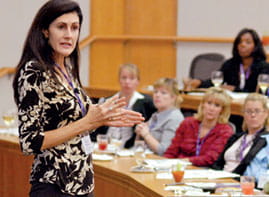The 2010 Kellogg Risk Summit takes a closer look at the interplay between marketing and risk management
12/2/2010 - Consumer behavior in the wake of the 2008-09 economic crisis has changed dramatically. Lenders need to understand and account for these changes as they consider when and how to begin loosening credit, according to Chisoo Lyons, vice president, analytics, at Minneapolis-based FICO.
“There’s no one who has not been impacted. Business models are changing; profit margins are slimmer; consumers are behaving differently,” said Lyons, who gave a keynote address during the conference at the Allen Center, titled “
Understanding the U.S. Consumer: Risk Management and Marketing Intertwined.” The Oct. 28 conference reflected Kellogg’s tighter focus on risk management since 2002.
As lenders figure out how to make their way forward through the “massive environmental changes” since the crisis, they need to realize that analyzing data from the past three years does not necessarily help predict the next three, and that waiting for more data might not be the best option, Lyons said.
The key to determining the best mix of actions is to introduce more narrowly segmented products for certain types of customers — and to think about whether other products remain necessary at all, she said.
“What can you do in this room? Make better decisions, one decision at a time,” Lyons said to those in attendance. “You need to find the tradeoffs: Is this the right customer to authorize? Are you losing a good customer if you don’t?”
| |
 |
Related Video |
|
| |
| |
|
One noteworthy change in consumer behavior is the rise in strategic delinquencies, particularly on residential mortgages — they have risen from 22 percent of foreclosures in March 2009 to 31 percent a year later. “You need to tease out those walking away from their bills strategically versus those who are just having trouble paying their bills,” she said. “This is the ‘new normal’ of consumer behavior.”
People who strategically walk away typically manage their credit well, spend carefully and have lived in their homes for short periods of time. Lyons said they’re identifiable in the data, and she believes they can be influenced through written materials and customer service calls detailing the consequences. “Some say, ‘Don’t bother, their minds are made up,’ ” she said. “I like to be a little more optimistic.”
An audience member expressed the opposite view, saying that he would prefer to educate those who are slipping behind without intending to, rather than guarding against the “rational actions” of those purposefully walking away.
Lyons mentioned that in the
Quarterly Survey of Bank Risk Officers conducted by FICO and PRMIA, the overall outlook toward credit conditions remains challenging. However, she sees some signs that credit lending is expanding.
The financial crisis has been painful for risk managers but also a learning opportunity, said Yan Chang ’06, vice president, risk management, Discover Financial Services, who gave another keynote address.
“As a risk manager, there are two things you need to do,” he said. “When things are going well, and you know why they’re going well, tell your managers. The second thing is, when things are not going well, you’d better know why, too.”
Discover, which offers bank deposits, loans and debit cards in addition to its better-known credit card business, first noticed things were not going well in late 2007 when mortgage delinquency rates spiked in Florida, Arizona, Nevada and California. An analysis showed that high-risk mortgages were the culprit, and the company adjusted its strategy in those states — but before long, the crisis had spread.
“What caused this? Borrowing more than what you produce,” Chang said. “You can blame it on the bubble, all this stuff. People wanted to believe in this thing. They kept on borrowing.”
Risk managers need to get back to basics and ask customers who are building up their balances why, and whether they have a solid plan to pay them back.
| |
|
| Read the current survey of bank risk officers, which finds persistent credit gaps facing consumers and small business owners |
|
| |
|
“We need to know more about our customers,” he said. “You’ve got to use that information for risk management.”
In the mid-2000s, less scrupulous risk managers almost seemed like they didn’t want to know the truth about their customers, lest it get in the way of making a loan, Matt Feldman ’86, president and CEO, Federal Home Loan Bank of Chicago.
“Supposedly knowledgeable investors find themselves relying on models, metrics and other investors to make decisions that are comfortable but not necessarily accurate, or correct,” he said. “The level of control in protecting how this market evolved was simply not present, but the illusion of control was. And the illusion was perfectly acceptable until it was no longer working properly.”
The illusion led to products like no-income-no-asset (NINA) loans, in which lenders did not ask for documentation and, in some cases, encouraged applicants to falsify information, Feldman said.
“They ask, ‘What do you earn?’ I tell them what I earn,” he explained, and the lender responds: “Maybe you should earn more. Let’s put down this amount.” Feldman added, “Don’t think that didn’t happen. Just as many [applicants] said, ‘He’s asking me what I earn, but he’s not going to check.’ ”
Due to these high-risk products, Feldman expects the wave of defaults to continue for a couple more years — and he says the list of people to blame is a long one that only begins with the Bernard Madoffs of the world.
“Bubbles create an opportunity for bad actors, but most of the damage is caused by well-meaning people engaging in crowd behavior caused by greed, folly, or both,” he said. “You can look at Madoff and point the finger, and talk about how horrible it was. But the real damage was caused by everyone else.”
Read the current survey of bank risk officers, which finds persistent credit gaps facing consumers and small business owners The conference, presented by FICO, Discover, and PRMIA, also featured a panel discussion that included
Russell Walker ’06, William Farrow ’79, president and CEO of Urban Partnership Bank; and William Panak, senior statistician and scoring officer, Capital One Financial.
In an interview (
watch video here), Lyons reflected on the impact the crisis has had on the risk management field. “Pre-crisis, we were the people everybody wanted to avoid. Now, we’re the people invited to all the meetings, and we’re in great demand,” she said. “It’s no longer the quirky little function that’s ignored.” Indeed, risk management is front and center in the recovery.
The next Kellogg Risk Summit will take place
Feb. 23, 2011 and will continue the dialogue on risk, with a focus on global risk.






